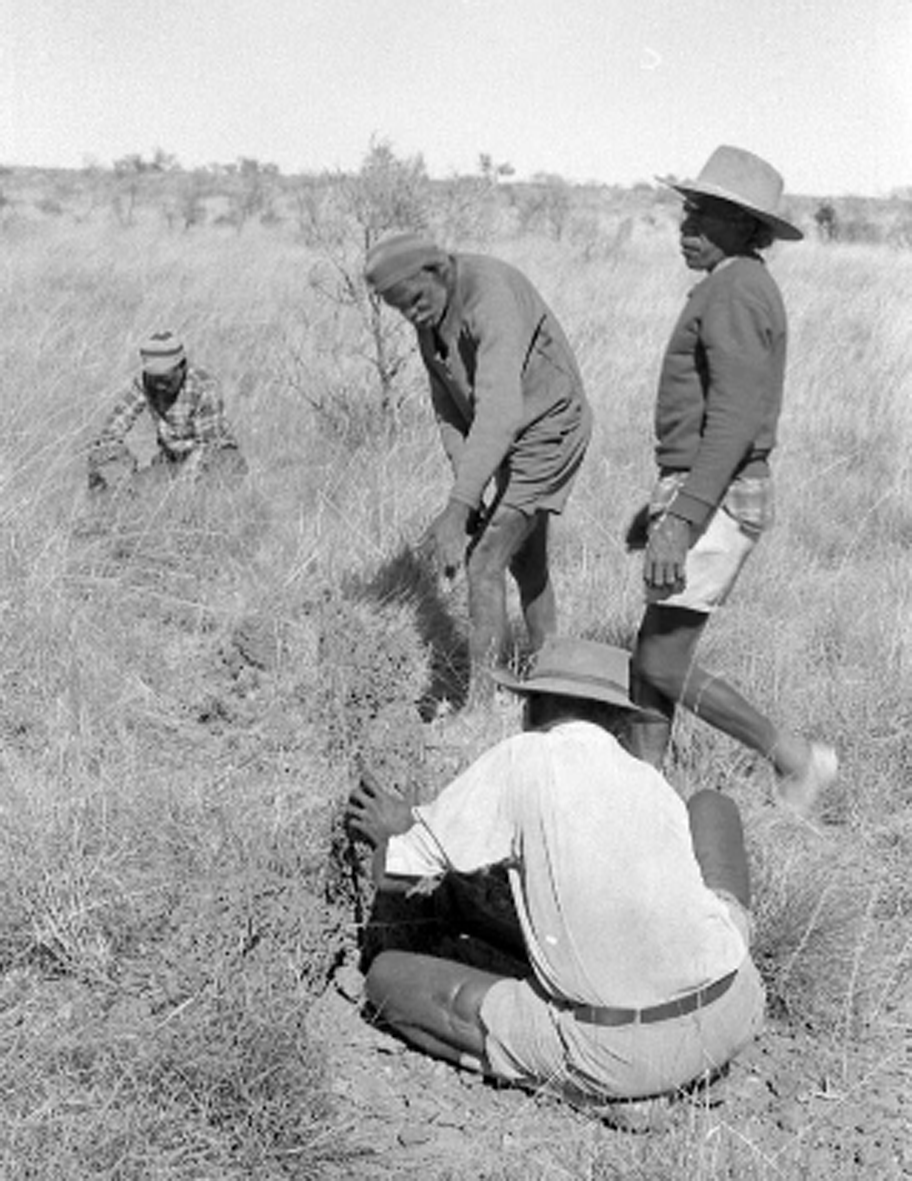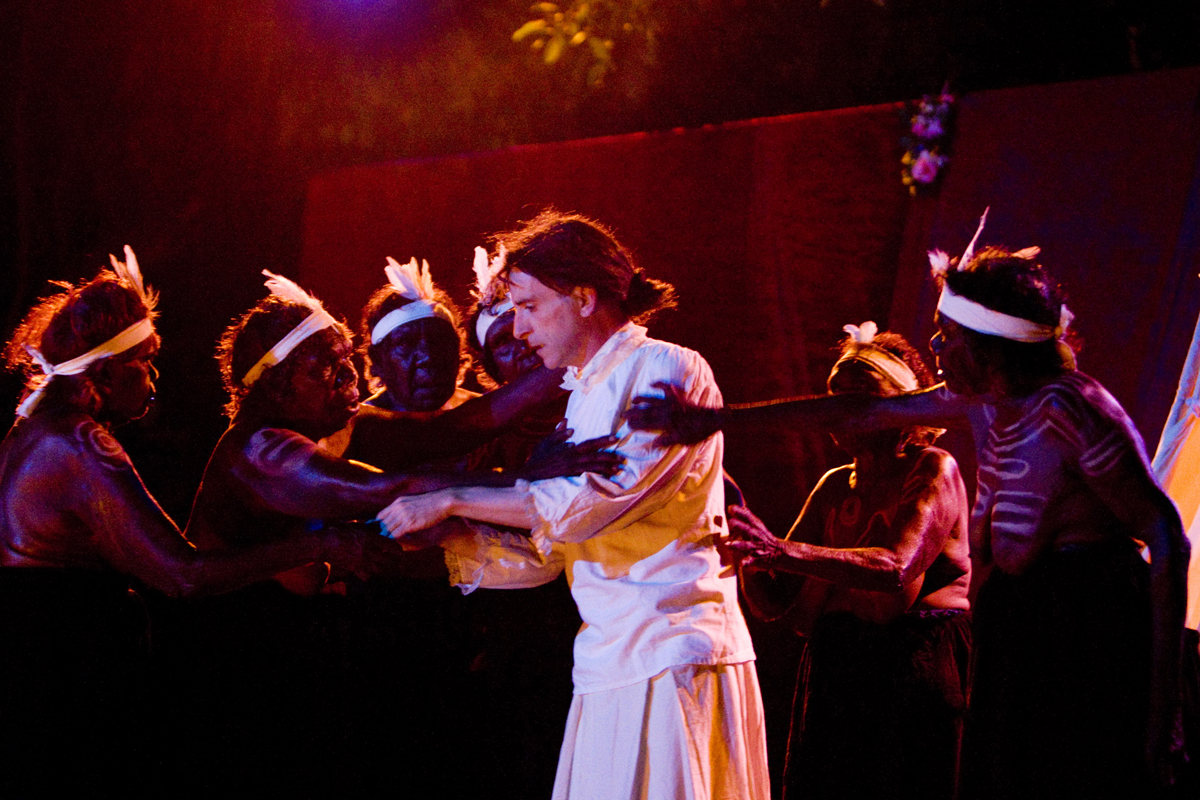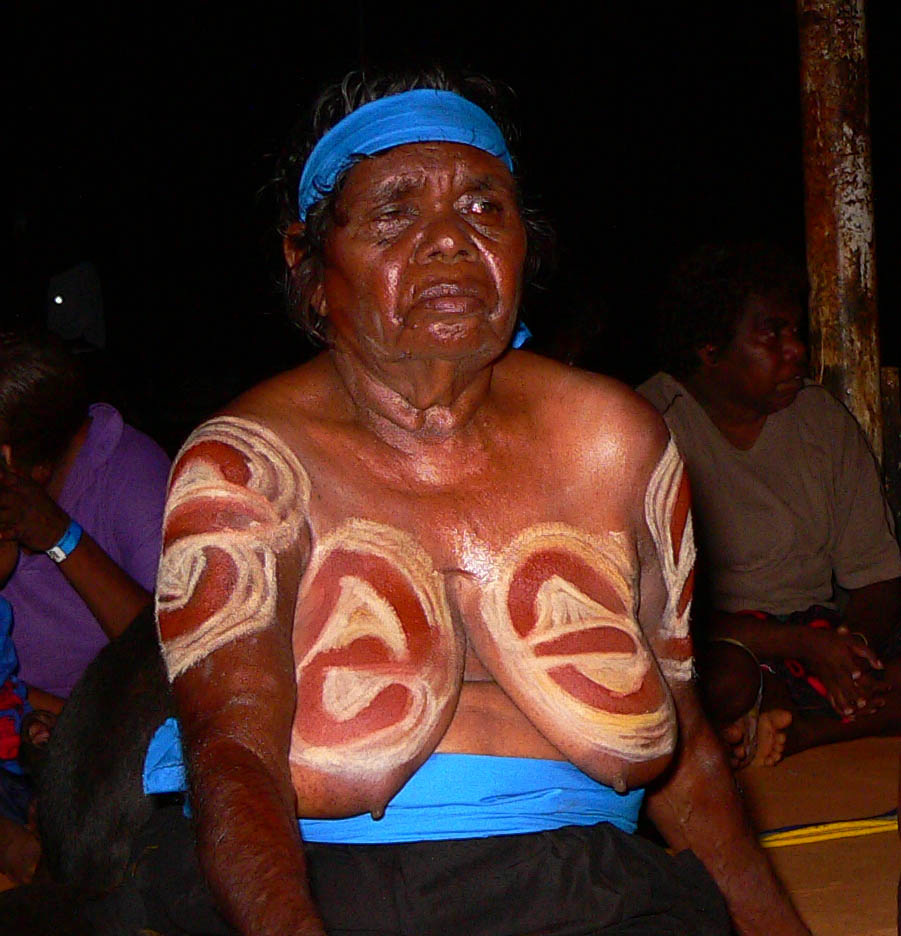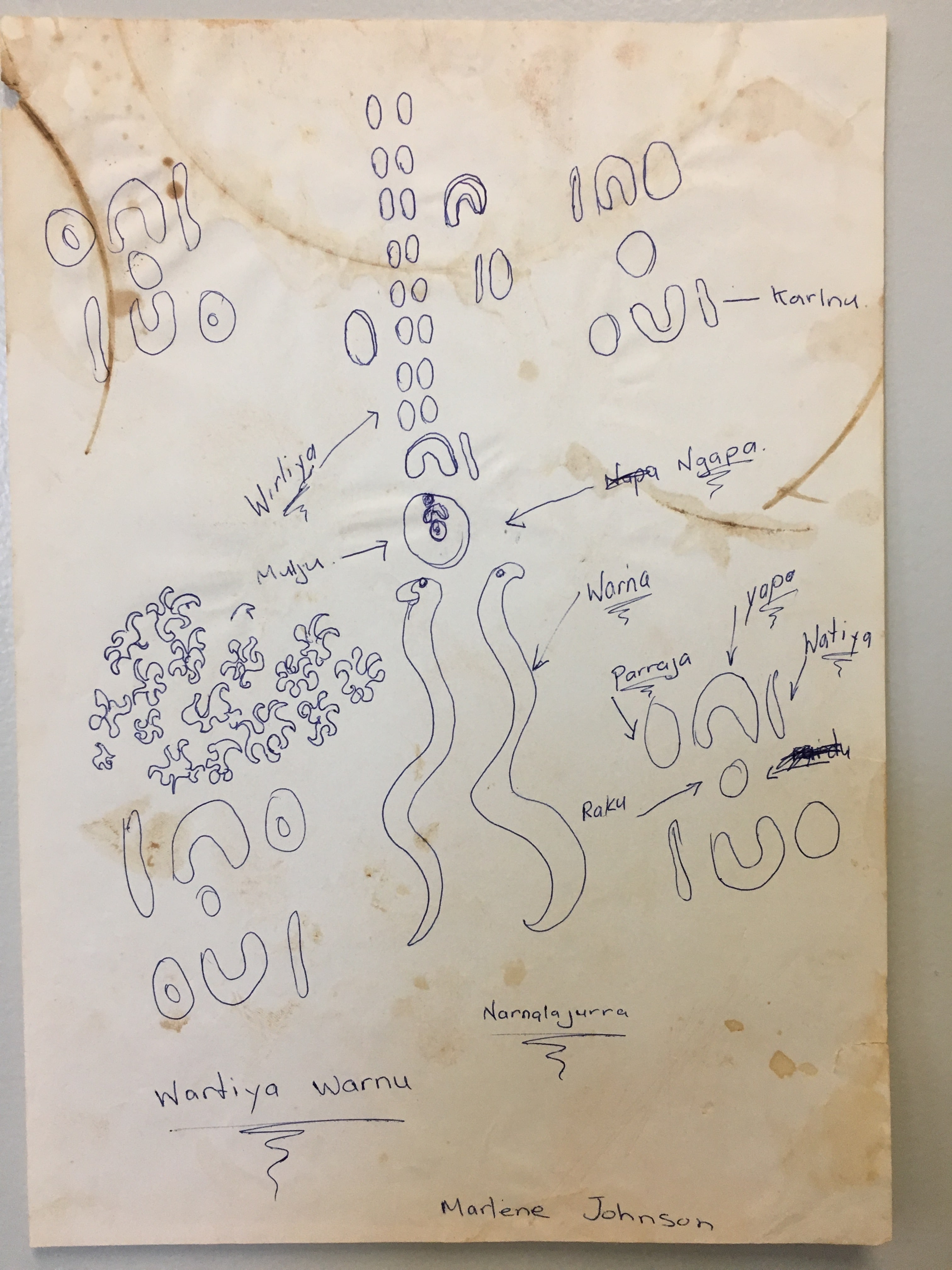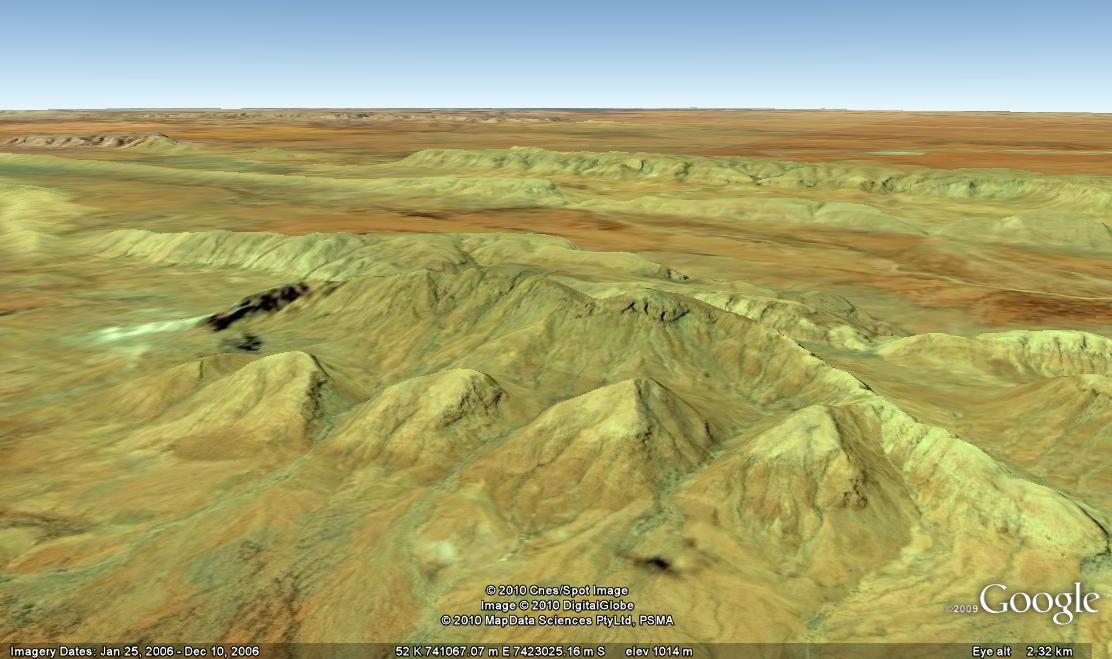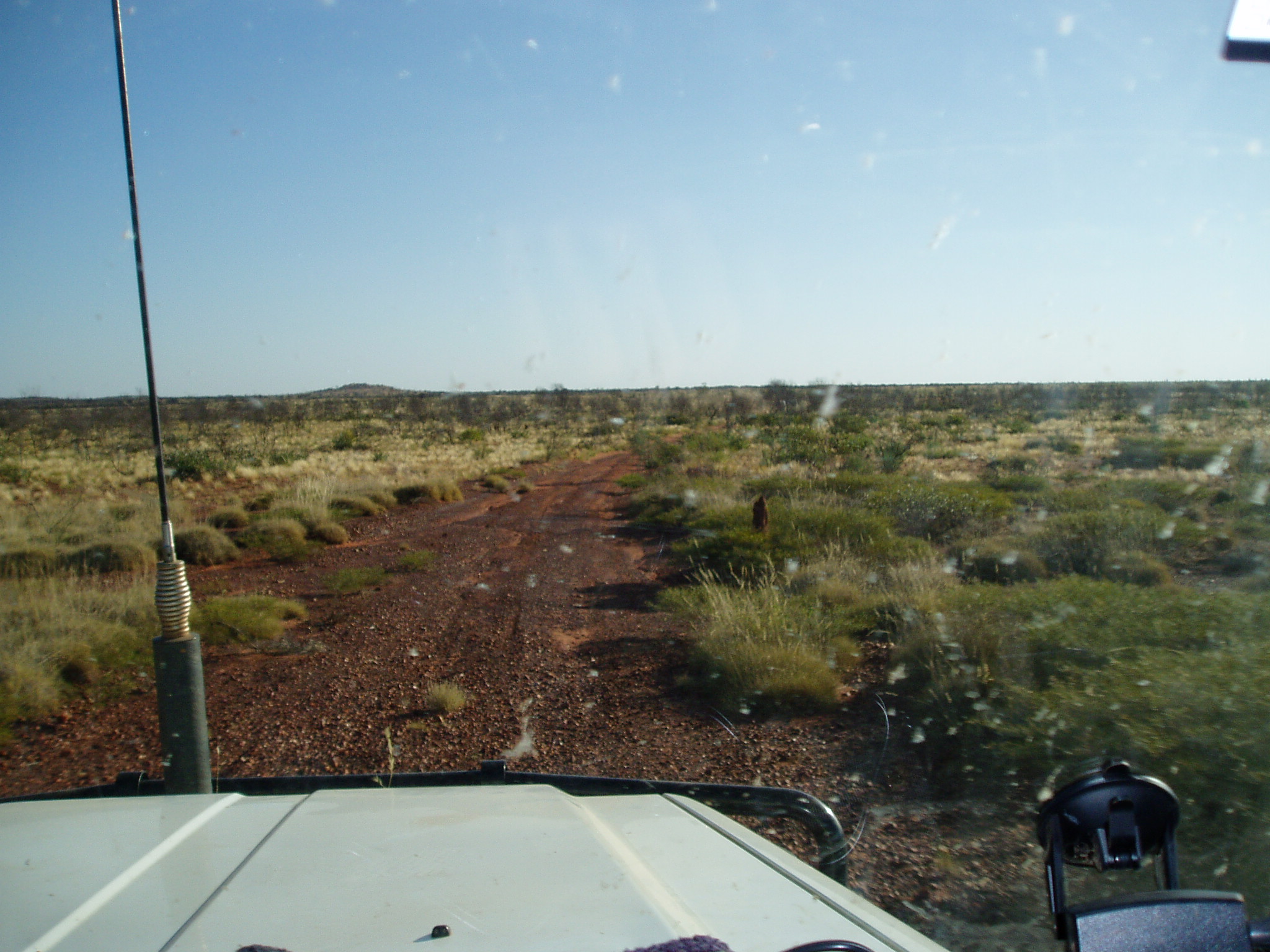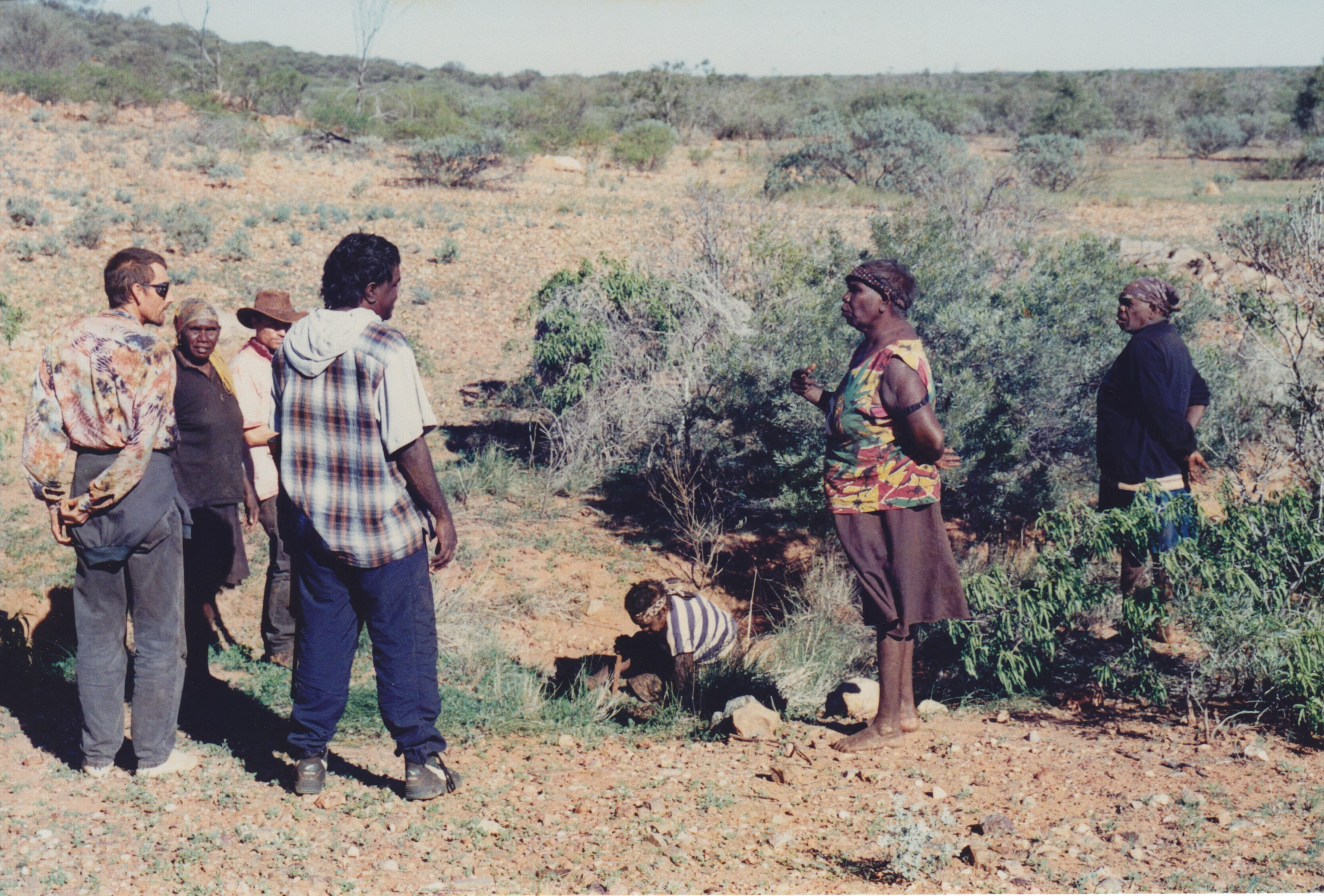Milpirri Banner - WATIYAWARNU (Wattle Seed Tree)
Dreaming
Watiyawarnu (or watiya-warnu) is Acacia tennuisima; a kind of wattle tree. It tells the story of dreaming ancestors collecting the ngurlu (seed) of the tree. In this banner design the two “c” shapes are women, one is Nangala and one is Nampijinpa. The line next to the women is a digging stick and the oval shape is a coolamon. The “o” shape is Parralyu (Mt Davidson). The tracks are the women walking around looking for watiyawarnu seed. The curved line is the snake from Jarluwangu. His personal name is Jakapawu, he is N/Japaljarri and N/Junganarrayi. The snake killed the two women there. While on the 2006 Ngapa Trip Rosie Napurrula Tasman showed the site and told how the snake ate the women, excreted them out and showed where you could see the blood and fat and bones of the women. (see photo below)
Belonging to Skin Groups
Jangala, Jampijinpa, Nangala and Nampijinpa (Blue Group)
Species
Acacia tenuissima
Biology and Image
Watiyawarnu (Wattle Seed Tree) - Photos / Information
Drawn By
Original banner drawing by Liddy Miller Nampijinpa, 2012
Family
Robertson and Brown families. Eddie Robertson in Yuendumu is a current senior person. In Lajamanu, people can speak with Liddy Nampijinpa Miller, or kurdungurlu which include family members related to Gladys Napangardi Tasman or Judy Napaljarri Walker.
Traditional Owner Profile
Liddy Nampijinpa Miller was born at Jila about 1940. She is a Warlpiri woman living in Lajamanu. Her country is Parrulyu/ Puyurru and her Dreamings are Ngapa, Yujuku and Watiyawarnu. She started painting in 1986 in the Traditional Painting course. Liddy has been a significant elder for her kinship group since the beginning of the Milpirri performances.
Source: Design and Art Australia Online
Traditional Stories
Billy Bunter Jampijinpa (dec) stated that “Watiyawarnu went from Pirdipirdi (Thomsons Rockhole) all the way around. It is a great big track with many songs. If you start at night, maybe 8:00 pm you will finish just before dawn. It’s public but it has higher levels in the Kajirri too. Peggy Napaljarri Rockman and Alice Napaljarri Tasman stated that they never cooked the Watiyawarnu, they would eat it straight off the tree. The Watiyawarnu seed is a special seed, they say the ground would burn if you didn’t treat it with respect.
Source: Holmes (2006) Law for Country: The Structure and Application of Warlpiri Ecological Knowledge, PhD Thesis, University of Qld
See Parrulyu and Pirdi Pirdi on the South Tanami IPA. Either click on the "Jukuurpa Yirdiyi Kari-Yardiyi Kari" tab, or change to English and click on the "Jukurrpa map" tab. Look East towards Yinapaka on the Lander River. Scroll up. - Map
Traditional Use
Watiyawarnu seed is collected when the seed pods just open and the hard seeds are hanging on the pods, but have not yet fallen. They are collected in large piles and threshed with sticks to dislodge the seeds. Then they are cleaned by winnowing in the wind. The watiyawarnu is edible but not good for seed cakes (it does not hold together in the ashes). It is eaten as a paste.
Place
Watiyawarnu travelled from Juntuwarriji (Mt Patricia) to Yamurnturrngu (near Mt Liebig) then back to Mt Patricia and on to Pirdipirdi (Thompsons Rockhole), and Parrulyu (Mt Davidson).
Source: Aboriginal Land Commissioner (1979) Claim by the Warlpiri and Kartangarurru-Kurintji Report by the Aboriginal Land Commissioner, Mr Justice Toohey, to the Minister for Aboriginal Affairs and to the Minister for the Northern Territory. Canberra: Australian Government Publishing Service.
Other significant places
Ngurlulirrinyinana is an ‘increase site’ which holds particular potency in relation to the rejuvenation of the species. A possible translation could be literally ‘seed is many’: lirri-nyina = be many; ngurlu = edible seed.
The series of hills adjacent to Mt Liebig are said to have been created by a Dreaming Ancestor in the form of an old woman who sat at the top of the mountain and endlessly ground watiyawarnu into enormous piles which in turn became the hills.
Source: Nash, Daphne 1984 An ethnobotanical study of women's plant use at Mt. Liebig. Unpubl. Litt. B. thesis. Australian National University, Canberra
Song
During 2016, Warlpiri women held three yawulyu revitalisation workshops in Yuendumu. Many generations of Warlpiri women attended, singing various yawulyu, painting the associated body designs, performing the dances and telling the associated stories.
Watiyawarnu Song and Story
The Watiyawarnu story provided here is from Liddy Miller Nampijinpa documented by anthropologist Barbara Glowczewski in 1995.
Song One: Watiyawarnu walyajarrija Ngurlulurru ngunanya [nyinanya
Commentary: That pirdijirri [seed cake] bin melt in fire not like other ngurlu [seed], not good for seed cake!
I sing him Parrulyu [Mt Davidson], two women, karntajarra [two women] bin walk around, Nangala and Nampijinpa [skin names of the two women], we start from that way. Only means Napurrula bin stand up there, end up in Parrulyu [Mt Davidson], Nangala and Nampijinpa bin makim ngurlu [seed].
Ngurlulurru they sat, that’s a really big camp for these two karntajarra [two women], two fella makin watiyawarnu [Acacia tenuissima seed]. This one, we start from that one now, Parrulyu area. Little bit sing Yamurndurrngu [a place] and come back again.
That’s the way we’re singing two families; Nampijinpa, you know Parrulyu mob and Yamurndurrngu mob. We company for that juju [ritual]. That the way junga [true] all the time.
Source: Barbara Glowczewski, (2001) Dream Trackers: Yapa Art and Knowledge of the Australian Desert. (Multi-Media Recordings of Lajamanu Area). Paris: UNESCO
Further reading
Watiyawarnu went to Pirdi-pirdi (Thompsons Rockhole). It was at this place that Olive Pink the famous anthropologist had her camp. For many Warlpiri Miss Pink (as she was called) was the first white person they had seen.
Read more about Olive Pink - Photo / Story
Read about Jerry Jangala’s first encounter with Miss Pink - Story
Olive Pink performance
Fierce was an artistic adaptation by Tracks Dance Company of the life of the anthropologist and botanist Olive Pink who was once labelled "the fiercest white woman in captivity". It was inspired by historical and fictitious elements relating to an encounter between Miss Pink and the Warlpiri people of Lajamanu. This first European contact took place in 1942 at Thompson’s Rock Hole. The performance featured the Lajamanu Yawulyu Women’s Dancing Group.
See photos and read more about Fierce, The Story of Olive Pink - Photos / Story
